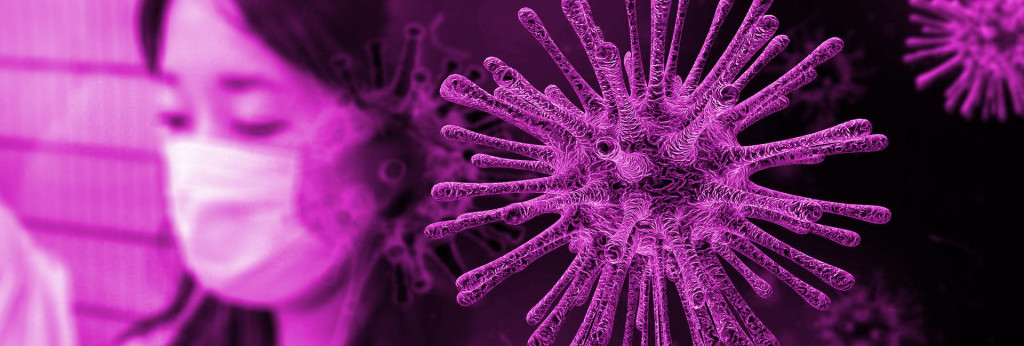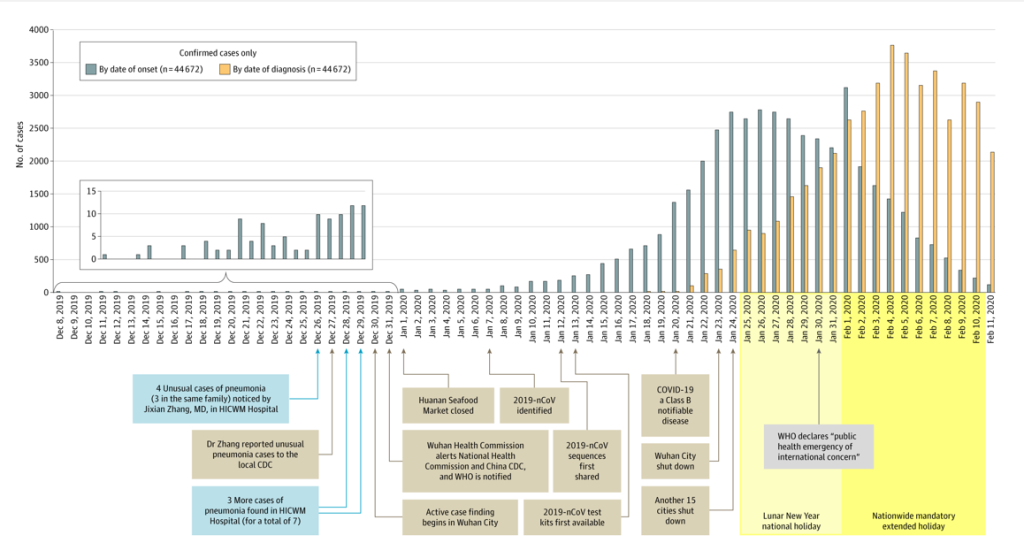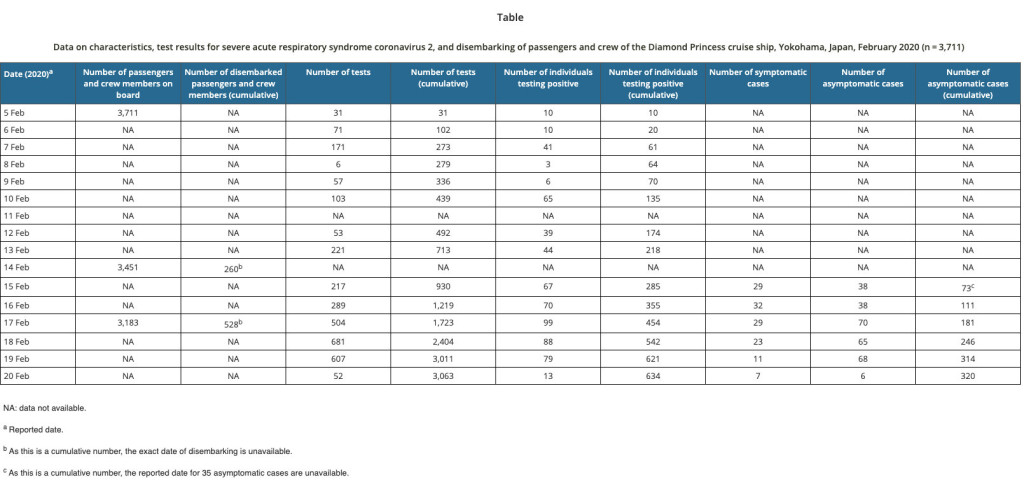Because we are also in a veritable crisis in crisis communication, it is difficult for laymen and experts to find common ground in what to believe. But we are not in a war of opinions or belief systems, this is not a political debate, but in trustful scientifically valid observations if something is happening or not. A new reality. In all that storytelling, the fiction which ruled our life till now, there is now a benchmark, a result of our pondering – do our predictions and actions match with the unfolding events out there, or not. Is someone getting sick nor not? Are Emergency rooms / ICUs overstreched or not, does the virus SARS-Cov-2 infect human cells and multiplies there, or not. Do we carry it around in substantial numbers also infecting others unknowingly, or NOT?
My suspicion was already in the first 3 weeks of March in that dark numbers may rule the scenario — and there is evidence and justified reason to think so now. That we do not have the full picture, is still true after Easter at the 14/04/2020…
Covid-19 is no fake news we are aware of now worldwide, it is a bitter reality which is overloading the health systems of the richest countries RIGHT NOW and in the times to come if we are not containing the virus or find a vaccine. While there is still much of discussion ongoing how bad it will be, and some regions are already easing the measurements it is not a question of IF it is happening, but WHEN. In Italy, where I live right now, we had 46.638 positively tested people, 5476 deaths and 7024 cured on 22/03/2020. Roughly 3 weeks later, on Easter Sunday 13/04/2020 there were officially 159.516 positively tested cases, 20.465 deaths and 35.435 cured.(http://www.salute.gov.it/portale/nuovocoronavirus/dettaglioContenutiNuovoCoronavirus.jsp).
WHAT could you LEARN in this article? First, to respect what we DO NOT know, about the dynamics of a multi-factorial outbreak situation. The dark numbers I propose as a concept of the all the numbers unaccounted of and tests we did not do so far — or could not do because of wild west methods of buying or rerouting materials or basic reagents. Second, if we DO NOT know how many people are REALLY infected at a given point in time and they are not to be spotted by symptoms in large numbers, WE ALL NEED TO WEAR MASKS to protect EACH OTHER when we go outside (shopping, working, etc.). That was not clear from the start and the confusion around masks was also coming from highest levels, the WHO and governments who often simply denied the effectiveness of masks, because they did not have ANY to distribute and left also health care workers unprotected. For the case of France read (in German): https://www.faz.net/aktuell/politik/ausland/nizza-fuehrt-als-erste-franzoeische-grossstadt-maskenpflicht-ein-16716014.html or the backtracing of the WHO: https://edition.cnn.com/2020/03/30/world/coronavirus-who-masks-recommendation-trnd/index.html and then later https://www.who.int/emergencies/diseases/novel-coronavirus-2019/advice-for-public/when-and-how-to-use-masks
Official numbers vs. true numbers vs. dark numbers
(Zunyou & McGoogan in JAMA. Published online February 24, 2020. doi:10.1001/jama.2020. 2648 This figure was adapted with permission. CDC indicates Chinese Center for Disease Control and Prevention; HICWM, Hubei Integrated Chinese and Western Medicine; 2019-nCoV, 2019 novel coronavirus; WHO, World Health Organization.)
Asymptomatic cases are missing in this account and they do not play into the official numbers, because they very rarely got tested and thus, registered. The statistics to show the true numbers from official ones working backwards and estimating the true ones are fine — ONLY it if they would encompass the asymptomatic ones, too. Those, who might NOT get sick themselves, but contribute (in a yet unknown amount) to the epidemiology of Covid-19.
There is an elephant in the room, probably explaining a lot of the spread: dark numbers, or asymptomatic cases who stay subclinical and do not develop symptoms (or only very mild ones one might not really recognise). How many are these? If we cannot screen for temperature or feeling sore or “sick”, cough, headache or throat ache, how shall we contain the virus? It seems to be proven that (unlike SARS) in Covid-19 cases people are already infective without symptoms (but may develop them at a later stage) AND that there is a significant percentage of “asymptomatic cases” which may NEVER develop symptoms but prove to be SARS-Cov-2 positive AND are spreaders. This calls quarantine and screening into question, but social distancing and wearing a mask is still the best way to fight a spread, BECAUSE we do not know who has it (or will get sick soon). I call them (to distinguish from Thomas Pueyo using “true” case) dark cases.
The IHS — Institute for Higher Studies in Vienna (Austria) thinks there are about 76% asymptomatic cases to expect and they also hint to the Italian community of Vò and a study of Univ. of Padua conducted there, at the first known cluster of the Covid-19 outbreak in Italy. See (in German) https://www.derstandard.at/story/2000115987433/zu-wenig-tests-zu-viel-spekulation-um-die-dunkelziffer
So, the dark numbers need to be differentiated into true numbers and asymptomatic ones, staying dark, because they do not get properly measured.
The case of Vò (Italy)
The Region is about to greatly enhance the ability to swab across the region. First of all, we will check all risk categories, all those most exposed to the public: carabinieri, police, cashiers, operators who are in contact with the public, health personnel. Afterwards we will go to the home of all those who complain of symptoms: we will test them, if they are positive we will put them in isolation and we will put all the contacts in isolation, in addition to testing all those within a radius of 100 meters.
The real problem is the asymptomatic positives, if we continue to send them around we will never eliminate the epidemic. https://www.ilgazzettino.it/nordest/primopiano/coronavirus_italia_news_virologo_asintomatici_problema_vero_epidemia-5108698.html
“We were able to contain the outbreak here because we identified and eliminated the ‘submerged’ infections and isolated them,” he said of the Vò approach. “That is what makes the difference.”
Narrow focus
“Given the limited testing to date, some deaths and probably the vast majority of infections due to SARS-CoV-2 are being missed. We don’t know if we are failing to capture infections by a factor of three or 300. Three months after the outbreak emerged, most countries, including the U.S., lack the ability to test a large number of people and no countries have reliable data on the prevalence of the virus in a representative random sample of the general population.” Still, Dr. John P.A. Ioannidis, professor of medicine, of epidemiology and population health, of biomedical data science, and of statistics at Stanford University and co-director of Stanford’s Meta-Research Innovation Center is founding his reasoning of the CFR only on the Diamond Princess case and the few cases in comparison in the US, dismissing the work of the Chinese authorities, South Korea or the high CFR in Northern Italy right now (6,5%!) – entirely. There are 72.000 people case scenarios here and I suggest he reads that and asks European fellow colleagues for their unfolding data (31.000 cases in Italy as of yet 19/03/2020 – ). https://www.statnews.com/2020/03/17/a-fiasco-in-the-making-as-the-coronavirus-pandemic-takes-hold-we-are-making-decisions-without-reliable-data/
…asymptomatic spread is “not the major driver” of the spread of the new coronavirus.”You really need to just focus on the individuals that are symptomatic,” he said. “It [the containment strategy] really does depend on symptomatic presentation.”
In contrast, according to Harvard Medical Schoo true cases, not yet registered (or staying unregistered) may be about 50x the registered official cases. Harvard Medical School / Massachusetts General Hospital released their estimate in a video recording of the MGH Medical Grand Rounds of 12/03/2020). You can watch it here: https://externalmediasite.partners.org/…/53a4003de5ab4b4da5…
So, if the actual (true) cases are 50x greater than the reported cases, they likely have 75,000 cases not-yet-registered in the United States already, echoes Jason Scott Warner (USA) @medium (15/03/2020 date of the post about statistics & math of Covid-19 where I found this) https://medium.com/@Jason_Scott_Warner/the-sober-math-everyone-must-understand-about-the-pandemic-2b0145881993).
As for 24/03/2020 there were 46.450 positive cases in the US with 593 deaths (see John Hopkins “real-time” data @ https://gisanddata.maps.arcgis.com/apps/opsdashboard/index.html#/bda7594740fd40299423467b48e9ecf6). 9 days earlier, on 15/03/2020 there were 1.678 positively tested according to WHO situation reports (see https://www.who.int/emergencies/diseases/novel-coronavirus-2019/situation-reports/).
That was rising to 582,594 positively tested in the US until 14/04/2020, 23,649 deaths and total confirmed 1,929,922 cases worldwide!
The broad picture
Numbers from China
Can we believe the official numbers from China as prominent German Virologist Alexander Kekulé is suggesting us do (hear in German in the end of the MDR podcast: https://www.mdr.de/nachrichten/podcast/kekule-corona/corona-kompass-kekule-ausbreitung100.html)? I hope so, but hope alone is not enough. The data from China should have informed us since the outbreak in Dec/Jan but there were a lot of voices being critical with the depth and sincerity of communication as the one-party system in China got challenged by suppressing the facts first and reacting slowly, then very drastically.
Supchina, the platform of China news built by veterans of China watchers Kaiser Kuo (ex-director for international communications for Chinese search engine Baidu) and Jeremy Goldkorn (founder of infamously shut down danwei.org) offered deeper insights into the situation in China. They also run the renowned Sinica podcast for years inviting prominent China journalists and China-watchers to participate in uncensored discussions about Chinese political and economic affairs and their editors usually express a more nuanced opinions. On 09/03/2020 their take on the Chinese numbers sound as follows: “The new official numbers from China, to be taken with a huge grain of salt, especially after Caixin confirmed that asymptomatic — but still contagious! — COVID-19 patients are not being counted in official numbers in many provinces.” (see https://supchina.com/2020/03/09/official-covid-19-cases-fall-in-china-but-can-we-believe-the-numbers/) and later cite e.g. Graham Webster(editor-in-chief, Stanford New America DigiChina Project) on 19/03/2020 when he tweeted:
When Chinese official sources report numbers amidst an unprecedented propaganda campaign and with existential risk to CCP rule on the table, don’t take them literally. Take them as what authorities want you to think and repeat.
Reports from China do indicate that the authorities were very well aware of the threat concerning asymptomatic cases and have known about the contagion risk:
The case of the Diamond Princess
The cruise ship Diamond Princess arrived off the Japanese coast in early February with more than 3,700 passengers and crew members from more than 50 countries and regions. It was placed under quarantine on 4 February 2020 after authorities found that a passenger who got off the boat in Hong Kong during its voyage tested positive for the virus. On 20 January 2020, an 80-year-old passenger from Hong Kong embarked in Yokohama, sailed one segment of the itinerary, and disembarked in Hong Kong on 25 January. He visited a local Hong Kong hospital, six days after leaving the ship, where he later tested positive for COVID-19 on 1 February. On its next voyage, 4 February, the ship was in Japanese waters when 10 passengers were diagnosed with COVID-19 during the unfolding of the 2019–20 coronavirus outbreak .
Mizumoto Kenji, Kagaya Katsushi, Zarebski Alexander, Chowell Gerardo. Estimating the asymptomatic proportion of coronavirus disease 2019 (COVID-19) cases on board the Diamond Princess cruise ship, Yokohama, Japan, 2020. Euro Surveill. 2020;25(10):pii=2000180. https://doi.org/10.2807/1560-7917.ES.2020.25.10.2000180
Their estimated asymptomatic proportion they conclude at 17.9% (95%CrI: 15.5–20.2%), which overlaps in their view with a recently derived estimate of 30.8% from data of Japanese citizens evacuated from Wuhan (the study cited above). The team around Mizumoto notes clearly:
Considering the reported similarity in viral loads between asymptomatic and symptomatic patients and that transmission of SARS-CoV-2 by asymptomatic or paucisymptomatic cases may be possible, even though there is no clear evidence as yet of asymptomatic transmission, the relatively high proportion of asymptomatic infections could have public health implications.
This reported “similarity of virus loads” another important part of the puzzle can be found e.g. in Zhou et al.: “The viral load that was detected in the asymptomatic patient was similar to that in the symptomatic patients, which suggests the transmission potential of asymptomatic or minimally symptomatic patients. These findings are in concordance with reports that transmission may occur early in the course of infection5 and suggest that case detection and isolation may require strategies different from those required for the control of SARS”. Look their whole account up at: Zou L, Ruan F, Huang M, Liang L, Huang H, Hong Z, et al. SARS-CoV-2 Viral Load in Upper Respiratory Specimens of Infected Patients. N Engl J Med. 2020;41(2):NEJMc2001737. https://doi.org/10.1056/NEJMc2001737 PMID: 32074444
That patients without symptoms can be very well contagious has been also assessed in this large study of “Clinical characteristics of 2019 novel coronavirus infection in China” by Guan et al. published in the New England Journal of Medicine doi: https://doi.org/10.1101/2020.02.06.20020974 on 09/02/2020 already. The full text can be downloaded here: https://www.medrxiv.org/content/10.1101/2020.02.06.20020974v1.full.pdf
The Japanese Ministry of Health, Labour and Welfare has stated on it’s official website concerning the Diamond Princess case that of 508 patients who have been discharged in Japan, 262 are symptomatic and 246 are asymptomatic, which excludes those returning on charter flights. https://www.mhlw.go.jp/stf/newpage_10251.html (with google translation). So, the Japanese authorities count 48% of asymptomatic cases in the remaining positive passengers of the Diamond Princess after 40 days since putting the ship under quarantine on the 4th of February. In domestic cases they report in a 717 patient example that asymptomatic pathogen holders were found in 88 cases – that would be ca. 12%.
Conclusions
- Wear masks when you are outside and learn how to properly wear them and take them on and off. Also home-made ones do prevent the spread of droplets to a certain degree and are better than nothing until better masks are more widely available — so you save others from your breath and cough even if you are without symptoms.
- Reliable estimates of the reproduction number and the death risk associated with COVID-19 are crucially needed to guide public health policy. The dark numbers or “asymptomatic proportion”, which is broadly defined as the proportion of asymptomatic infections among all the infections of the disease is a useful quantity to gauge the true burden of the disease and better interpret estimates of the transmission potential. Asymptomatic or minimally symptomatic patients do expose a viral load comparable to cases with symptoms (fever, throat ache, cough), so there is no scientific reason not to take these findings seriously. How much they prove to be contagious and infect other people — is there a reliable R0 for asymptomatic cases estimated or validated, no–remains in the dark also until Easter, even though there were large serological test with representative groups being proposed and conducted. It is still fair to say that the dark numbers might affect the spread of the SARS-Cov-2 virus and may pose a threat as a residue of new clusters, now and when official numbers dwindle.
- Dropping the guard might lead to a surge of infected, as many are not aware of being actually contagious and might spread the virus because of bad compliance or “disaster fatigue”. This experiment we see happing now (14/04/2020) as governments are competing with each other who might be first to get back to an “acclaimed” normalcy. Let’s watch Austria and the Veneto region in which I live, where the governor Luca Zaia has just eased the measures. The results we will see in positively tested cases in about 2 weeks…
- Let’s watch closely what happens in China after the lockdown. On 23/03/2020 Caixin Global reports (see https://www.caixinglobal.com/2020-03-23/despite-official-figures-wuhan-continues-to-find-new-asymptomatic-covid-19-cases-daily-101532880.html ) that despite official figures proclaiming that no new domestic Covid-19 cases occurred, authorities continue to register asymptomatic cases, sometimes “a dozen a day”.
According to a member of the infectious disease prevention and control team in Wuhan, every day the city continues to record “several or more than a dozen asymptomatic infected individuals,” which are people that have tested positive for Covid-19, but do not feel ill and are excluded from published numbers.
The infectious disease prevention and control team has stayed behind, after Hubei’s provincial Covid-19 task force on Friday ordered it to remain.
5. More (validated) tests please, in the millions. Now. Not in 6 months. And make proper random tests if test capacity allows only for that, with representative groups to find the amount if real infected in the population and how many of the had symptoms and how many are immune…and for how long. IgM, IgG and other serological laboratory blood data may help us to understand how many people came into contact for real and it may help us to understand the proportion of deaths and severe cases better.
If we forget the asymptomatic ones out there, which may make up between 12-75% of the infected people, we will have a hard time to get rid of this SARS-Cov-2 / Covid-19 pandemic and face a long time of recurrent clusters of infections and “necessary” lockdowns which could have gotten avoided in first place by due diligence.
This article has been also published first as a Facebook note on 23/03/2020 in my FB profile https://www.facebook.com/notes/herwig-egon-casadoro-kopp/dark-numbers-rule/10158103025998834/
& on MEDIUM on 24/03/2020 https://medium.com/@hrwgkpp/dark-numbers-rule-5535e449b63b
and got amended and updated on the 14/04/2020.



